Neal Stephenson Reveals How He Created the Metaverse
When New York Times bestselling author Neal Stephenson first coined the term metaverse in his 1992 cyberpunk novel Snow Crash, he set a high bar for other science fiction authors to come, including the worlds subsequently created in films like The Matrix. His immersive literary technique and attention to detail in each of his works – Seveneves, Anthem, Reamde, and Cryptonomicon – have created a world that, today, we are actually working to build: this next-generation information era, dubbed Web3.
As one of the most popular sci-fi books of all time, Snow Crash’s first inception was a graphic novel undertaken by Stephenson and artist Tony Sheeder in 1988 called Dioxin Posse. However, the publisher rejected its manuscript, as the printing costs were upwards of $20,000, forcing Stephenson to write Snow Crash as a novel.
Fast forward to 2023, and Stephenson’s vision of the metaverse is finally taking shape, where questions of identity and infrastructure are finally front and center. What better way to celebrate than by looking back to where it all began? On February 27, 2023, Sotheby’s will recognize the author with Snow Crash, an auction of six physical and digital items connected to the revolutionary novel. This sale also includes Infocalypse, an open edition collection of digital art designed for, or derived from, Dioxin Posse.
Stephenson sat down with nft now to talk about this upcoming sale at Sotheby’s, in addition to how questions pertaining to identity, fashion, and metaverse infrastructures are beginning to take form.
nft now: How did the idea of auctioning off some of the original Snow Crash manuscripts come to be with Sotheby’s?
Neal Stephenson: The project started early last year and has been in the works for about a year now. We were talking about doing some NFTs, and at that point, the field was wide open in terms of where we might sell those. That led to the idea of auctioning off the original manuscripts, which is a different kind of auction, obviously, that makes you think of the classic auction houses like Sotheby’s and Christie’s. Also, the owner of the original artwork for the cover of the mass-market paperback of Snow Crash approached us, wanting to auction it off, so that has also been rolled into this.
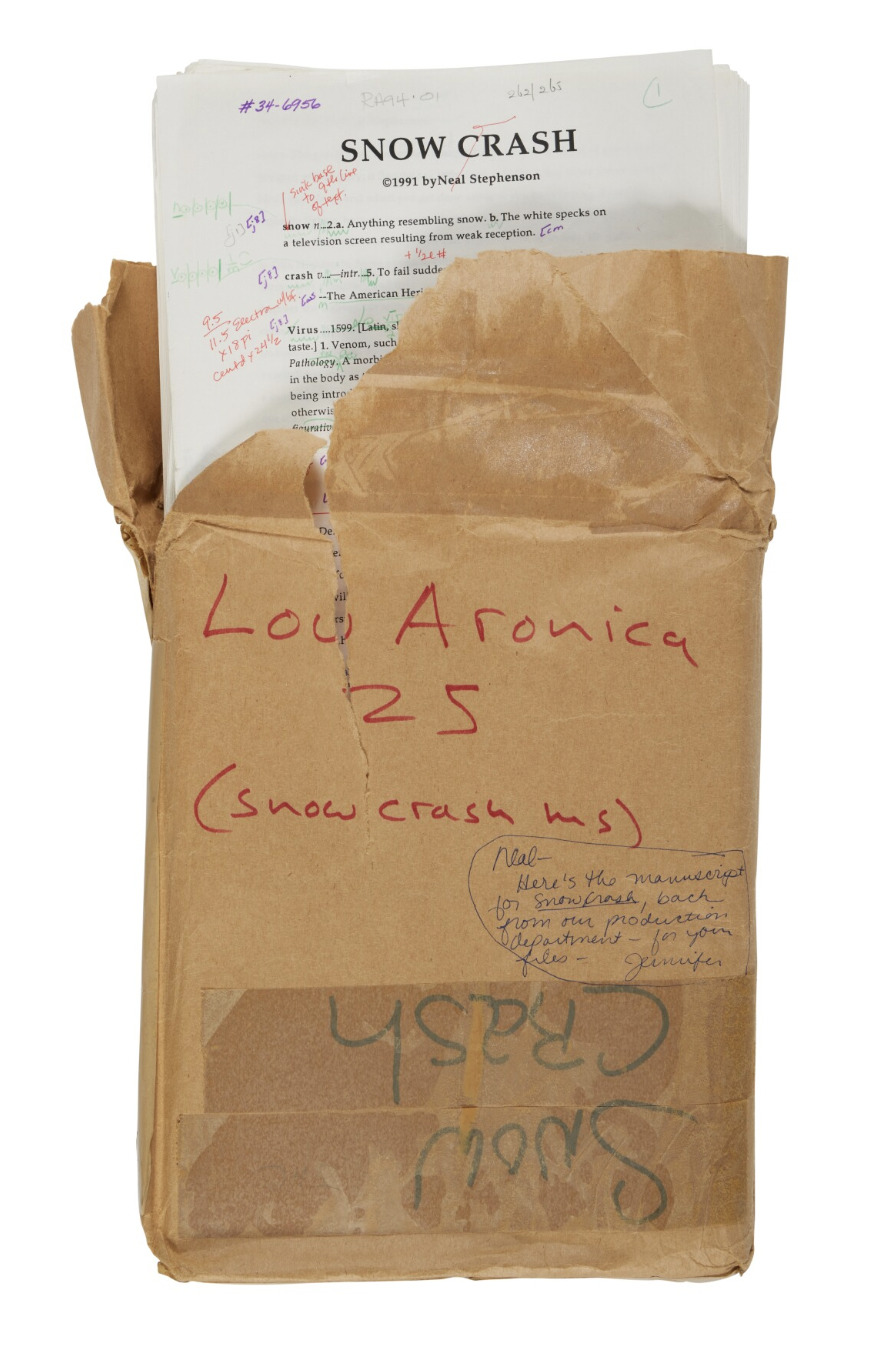
nft now: One of the more unique items that will be available at Sotheby’s is a katana sword, dubbed “Sword 1” – what can you tell us about it?
NS: Since late 2020, we’ve been working on the Snowcrash sword project with Weta Workshop, the New Zealand craftsman guild that created all the props and weapons for the Lord of the Rings trilogies. The idea behind “Sword 1” and the one I own, “Sword 0,” is that it was meant to be an actual physical recreation of Hiro’s sword as described in Snow Crash.
“Sword 0” started in 2014 and finished in 2018. However, “Sword 1” is a new creation and the one that will soon be available for auction. The sword is a physical object and a work of fine art; it’s a magnificent object that deserves to be sold in a traditional auction house like Sotheby’s.
Weta is incredibly particular in that they want to know every detail of the backstory of it before they start designing and working on it. And you can see that in everything that they have made as movie props. So, for “Sword 1,” I had to supply Weta with new information about the background of the families involved and how this sword came into Hiro’s possession. As a result, it caused me to begin writing some new original story material in the Snow Crash universe during 2014-2015.
The idea that both Richard Taylor at Weta and I came up with was: why not make more of these, use some of the new story material from the Snow Crash universe that nobody knows about, and use it as the basis for creating new swords? Even more elaborate and magnificent than the one I’ve got.

nft now: Let’s turn to your generative NFT art project, Infocalypse, which is also part of the Sotheby’s auction.
NS: In 1988, four years after the original Macintosh computer came out, Tony Sheeder and I started talking about a graphic novel project called Dioxin Posse, and we were going to use computers to do it.
He had never used a computer with a mouse before, so he came to my house, and I fired up MacPaint and explained to him how to use the mouse. He sat down and drew this line-drawing cartoon of a face – and we named him Elmo. I loved the image, so I saved it and preserved it. We used it as kind of like a mascot or logo for a while, but the graphic novel project ended up going nowhere as a business proposition, and I later wrote Snow Crash.
Last year, we started thinking about this auction, and we were scrambling around trying to find the original artwork we produced circa 1989 for Dioxin Posse. Tony had printed out the artwork on a color printer and pasted it up on poster boards, but those had been destroyed in a flood.
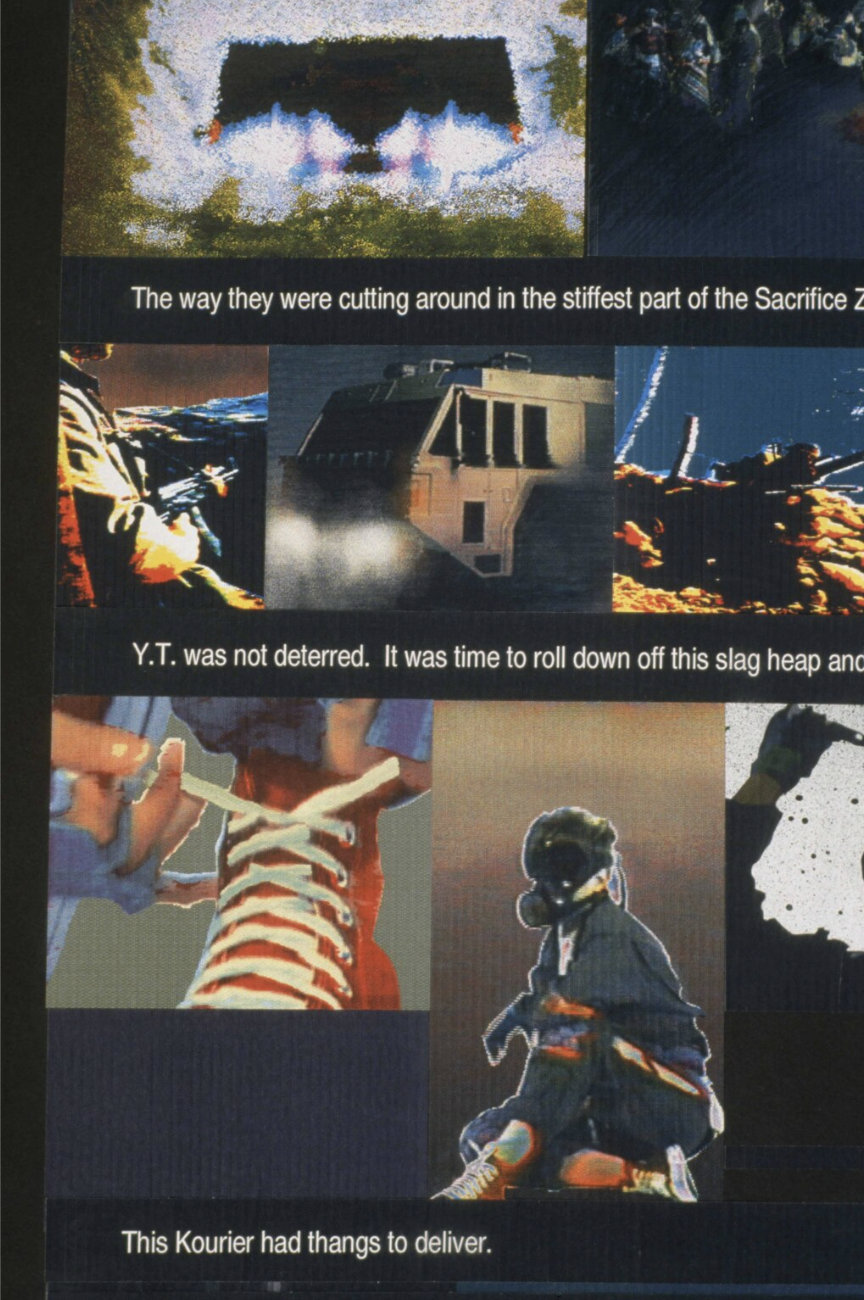
But, he was able to find ten 35 mm slides that we had shot of that artwork, so one of the lots in the Sotheby’s auction is going to be those slides and high-resolution digital scans of the slides that will also be sold as NFTs. One of those pictures was Elmo, so from that, Tony came up with the idea of doing this generative art project and using generative techniques to make thousands of unique variations of the Elmo face with different backgrounds and color palettes.
nft now: What about generative art do you feel resonates with you most?
NS: It’s a natural fit with the digital ethos of the NFT marketplace, and where I think it gets interesting is in the editorial process, where humans are involved – not just running an algorithm and spitting out a bunch of images randomly. Rather, you’re evaluating each one and asking, ‘do I like this? Is it unique? Does it stand out from the others in some way?’
Over the last month, Tony and Sterling have been sifting through the output of this algorithm and painstakingly going over all of these things. For us, it’s a way to make artwork that addresses a broader market. It’s fine to do fine art and sell one thing for a lot of money, but at the same time, you don’t want to shut out collectors who want to get in at a more reasonable price point.
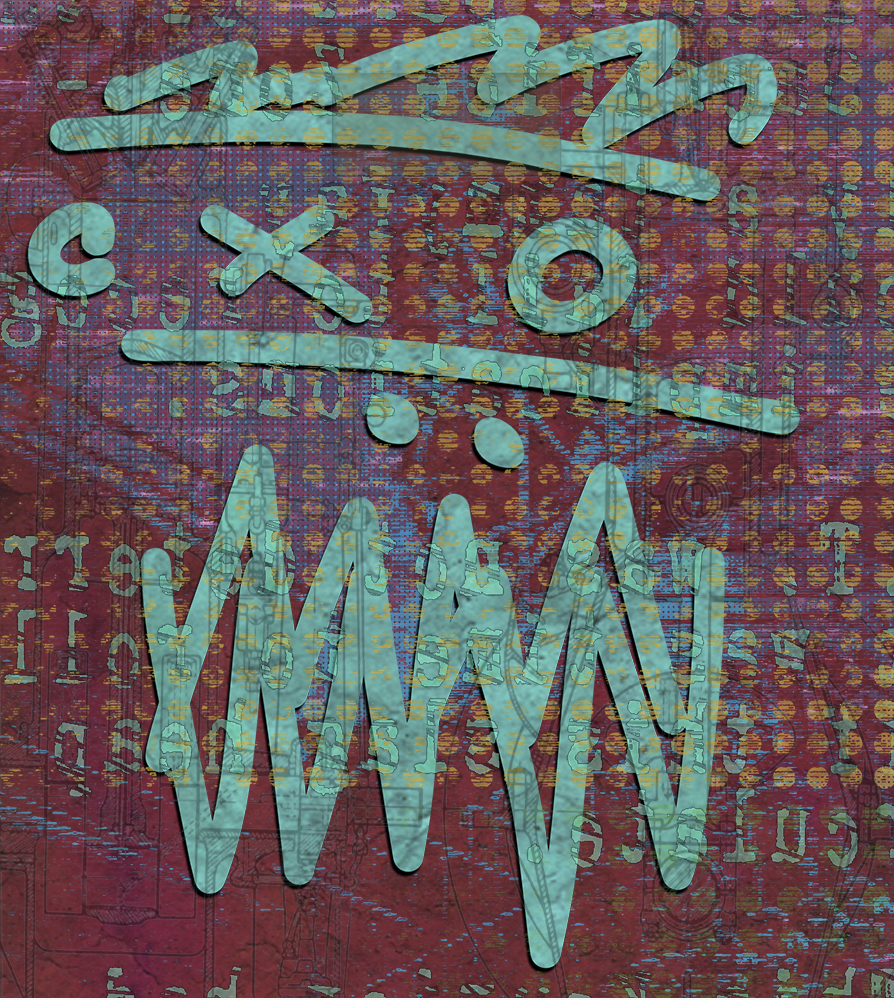
nft now: Where do you think our focus should be right now in the current NFT market?
NS: My interest right now is in the legal rights of both buyers and sellers in this market because right now, they don’t have any. We use the term ‘smart contracts,’ but they’re not contracts in any sense of the word. We also talk about how supposedly the artists are going to get secondary royalties and secondary sales, but that’s completely voluntary, and buyer’s rights are also pretty nebulous.
Normally, if you sell something to someone, one of the steps in that process is having to prove that you actually own the thing that you’re selling. None of that is in place here, which is why we are doing an experiment with a company called V Copy, which is run by Josh Kramer, whose background is in entertainment law. In working with Josh, we hope it’ll be a step forward in addressing some of these issues.
nft now: Turning to Snow Crash, what was your spark for creating this “Metaverse” world that has come to define today’s “Web3” tech boom?
NS: When we were working on Dioxin Posse, I ended up writing a lot of code with image processing software that was intended for making art. I ended up buying a lot of shit, including a very expensive computer monitor. The impression I came away with was that the potential of computer graphics was incredible, particularly 3D-rendered scenes that you can interact with.
However, it was incredibly expensive and hard to use at the time, which is where the science fiction idea came in – what would be the TV of 3D computer graphics? You made the analogy to Grand Theft Auto, which obviously didn’t exist at the time, but it’s not a bad analogy. And that’s the vibe that you see. It’s that Starsky & Hutch, A-Team, and The Dukes of Hazzard style content.
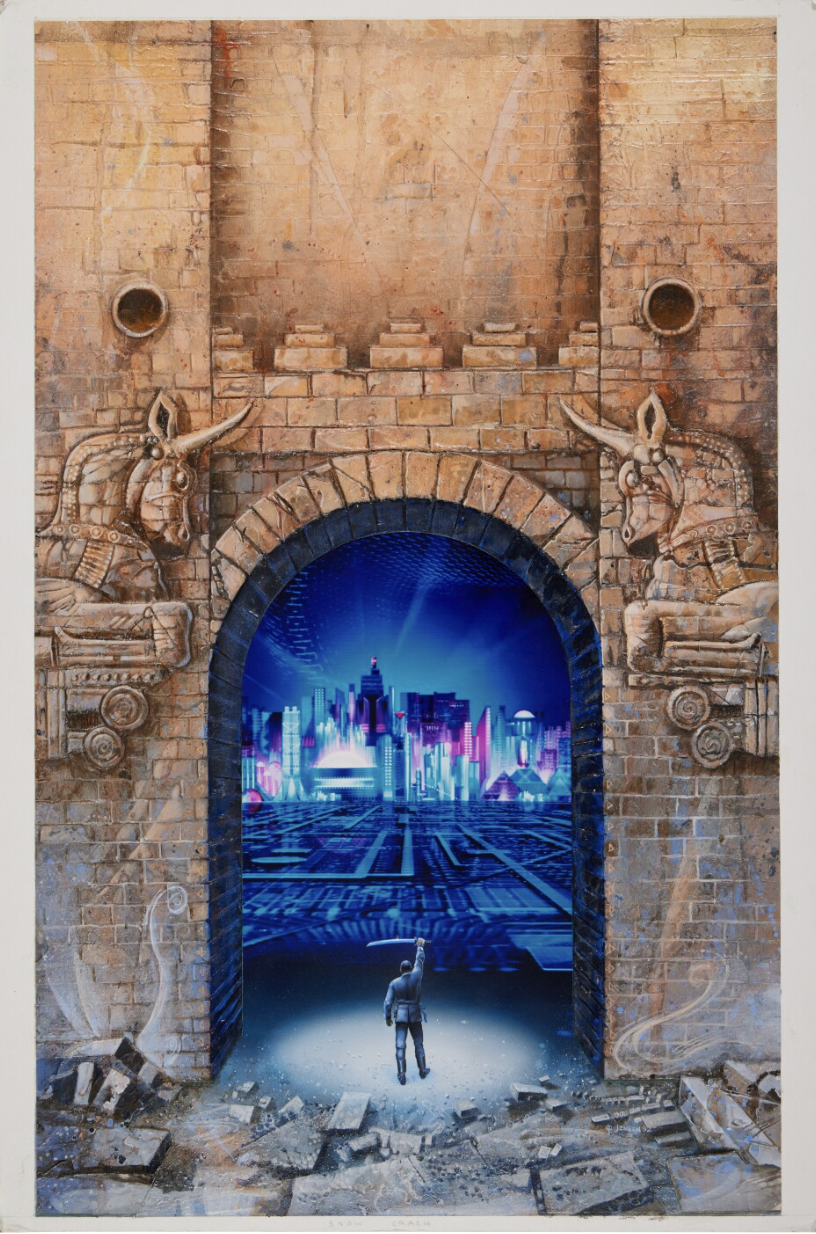
nft now: Today’s visualization of the metaverse seems to impart that certain mechanisms or rules are made to be broken. Can you speak to that?
NS: Starting with the premise first, I think we have to have the rules, otherwise, we can’t make a coherent metaverse. And the thing that weirdly got me thinking about this was a book published by Apple in the 80s called The Apple Human Interface Guidelines.
This handbook captured the reason as to why all Mac applications had common features, including the way the buttons behaved, the menus worked, etc. And some people ignored it and did whatever they wanted, but for the most part, Apple understood that they were going to get greater uptake and reach the market better if their app looked and behaved the same as all the other apps. So, I did the science fiction thing and asked what the metaverse equivalent of that would look like – and that’s where I came up with the idea that there would have to be certain rules in this metaverse, such as gravity always in one direction.
nft now: Let’s talk about these rules as it pertains to the novel’s depiction of “avatars.”
NS: There’s some kind of general respect for the laws of physics, which must be present for a metaverse to exist at all. Since this was a cyberpunk novel, there had to be hackers who hack something, which is why we see Hiro and other characters finding ways to circumvent these rules and make their own workarounds.
nft now: With these avatars, there seemed to be an element of tangibility attached to them throughout the novel, such as the ability to go and purchase “Brandy” at the local Walmart. Does that same element of tangibility exist with today’s avatar?
NS: I think there are some things that are no longer possible today, but we do have avatars in the form of two-dimensional PFPs, and names in a Slack channel or Discord. And people care about those a lot and put a lot of effort into finding avatars they like – even if it’s just a thumbnail man in a three-dimensional environment.
When we think about avatars, we think of some crazy, non-realistic ones. However, for these people who design and sell fashion, having realistic avatars that actually looked like the owner was really important because what they want to do at the end of the day is sell clothes.
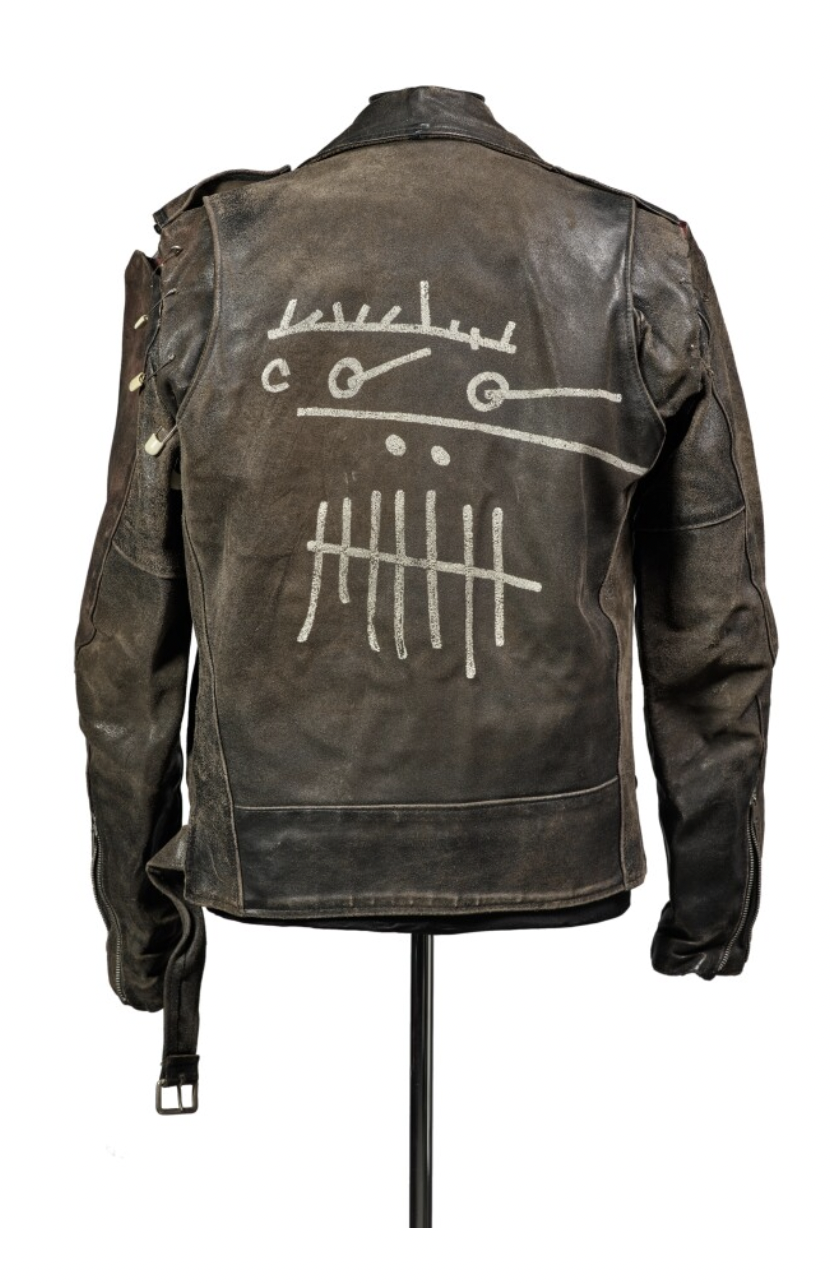
nft now: So, we aren’t necessarily missing the mark?
NS: I think all of that is going to happen…even the situations where people don’t want to look like themselves, whatever the underlying reason is. I think people are going to have wardrobes of different avatars that they can choose from. And from there, that’s where we get into all kinds of questions about how to implement and actually make that work.=
nft now: How would you explain the current tension between IRL and digital identity?
NS: There has been tension between anonymity and the potential for abuse. We now see that bot accounts and fake accounts online have been weaponized by sophisticated, well-financed actors as a way of distributing misinformation.
We’ve also seen innovations that have happened within the last month with AI-driven systems, which make those weaponized systems much more. It’s been an ongoing source of trouble, which is probably going to get worse – and that is a clash between the original idea of the 1990s idea of the internet, which is the kind of idealistic, academic hippie who wants to improve the world, versus what happened when bad actors realized how powerful the internet could be.
nft now: With tech innovation at its highest right now, will we see a single metaverse – or will we continue to see multiple metaverses that are built “bottom-down” by decentralized infrastructures?
NS: I don’t think it’s super complicated. If our vision of the metaverse is something that millions or even billions of people use happily in a productive way, then there have to be experiences there that people enjoy. So who’s going to make those experiences? Right now, the people who know how to make experiences that are actually fun are, by and large, a group of people who work in the gaming industry – and those experiences tend to be artistically rich, nice to look at, and fun to interact with.
nft now: Does the gaming sector have it right?
NS: One major roadblock when it comes to creating VR or AR experiences is asking how to break through these markets – commercial, industrial, military, medical, and educational – and make them interesting to a vast consumer market. I think the gaming industry is just miles ahead in actually achieving that.
The post Neal Stephenson Reveals How He Created the Metaverse appeared first on nft now.

